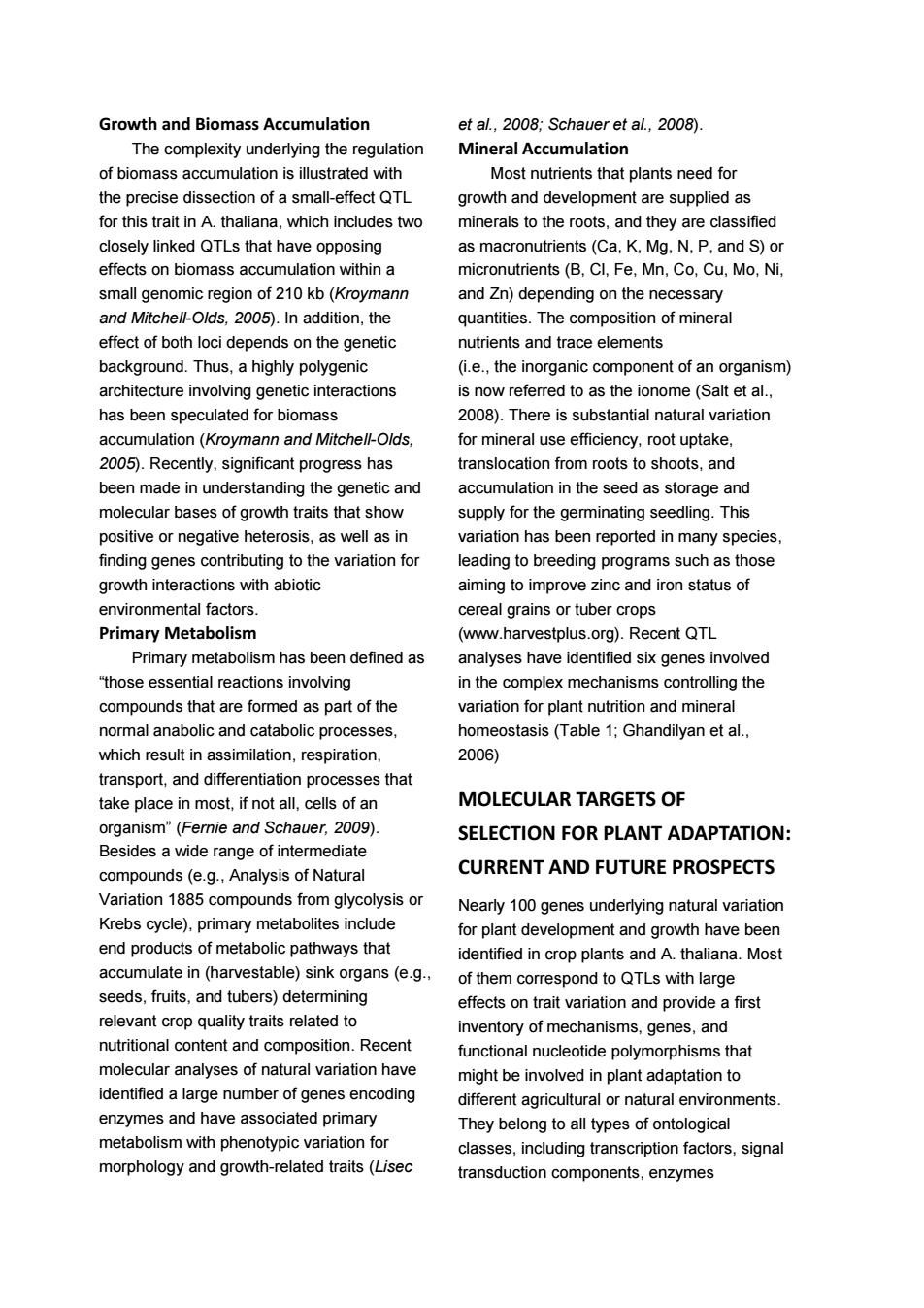正在加载图片...

Growth and Biomass Accumulation et al..2008:Schauer et al..2008) The complexity underlying the regulation Mineral Accumulation of biomass accumulation is illustrated with Most nutrients that plants need for the precise dissection of a small-effect QTL growth and development are supplied as for this trait in A.thaliana,which includes two minerals to the roots,and they are classified closely linked QTLs that have opposing as macronutrients(Ca,K,Mg,N,P,and S)or effects on biomass accumulation within a micronutrients(B,Cl,Fe,Mn,Co,Cu,Mo,Ni, small genomic region of 210 kb(Kroymann and Zn)depending on the necessary and Mitchell-Olds,2005).In addition,the quantities.The composition of mineral effect of both loci depends on the genetic nutrients and trace elements background.Thus,a highly polygenic (i.e.,the inorganic component of an organism) architecture involving genetic interactions is now referred to as the ionome (Salt et al., has been speculated for biomass 2008).There is substantial natural variation accumulation (Kroymann and Mitchell-Olds, for mineral use efficiency,root uptake, 2005).Recently,significant progress has translocation from roots to shoots,and been made in understanding the genetic and accumulation in the seed as storage and molecular bases of growth traits that show supply for the germinating seedling.This positive or negative heterosis,as well as in variation has been reported in many species finding genes contributing to the variation for leading to breeding programs such as those growth interactions with abiotic aiming to improve zinc and iron status of environmental factors. cereal grains or tuber crops Primary Metabolism (www.harvestplus.org).Recent QTL Primary metabolism has been defined as analyses have identified six genes involved "those essential reactions involving in the complex mechanisms controlling the compounds that are formed as part of the variation for plant nutrition and mineral normal anabolic and catabolic processes. homeostasis (Table 1:Ghandilyan et al.. which result in assimilation,respiration, 2006) transport,and differentiation processes that take place in most,if not all,cells of an MOLECULAR TARGETS OF organism"(Fernie and Schauer,2009). SELECTION FOR PLANT ADAPTATION: Besides a wide range of intermediate compounds(e.g.,Analysis of Natural CURRENT AND FUTURE PROSPECTS Variation 1885 compounds from glycolysis or Nearly 100 genes underlying natural variation Krebs cycle),primary metabolites include for plant development and growth have been end products of metabolic pathways that identified in crop plants and A.thaliana.Most accumulate in(harvestable)sink organs (e.g., of them correspond to QTLs with large seeds,fruits,and tubers)determining effects on trait variation and provide a first relevant crop quality traits related to inventory of mechanisms,genes,and nutritional content and composition.Recent functional nucleotide polymorphisms that molecular analyses of natural variation have might be involved in plant adaptation to identified a large number of genes encoding different agricultural or natural environments enzymes and have associated primary They belong to all types of ontological metabolism with phenotypic variation for classes,including transcription factors,signal morphology and growth-related traits(Lisec transduction components,enzymesGrowth and Biomass Accumulation The complexity underlying the regulation of biomass accumulation is illustrated with the precise dissection of a small-effect QTL for this trait in A. thaliana, which includes two closely linked QTLs that have opposing effects on biomass accumulation within a small genomic region of 210 kb (Kroymann and Mitchell-Olds, 2005). In addition, the effect of both loci depends on the genetic background. Thus, a highly polygenic architecture involving genetic interactions has been speculated for biomass accumulation (Kroymann and Mitchell-Olds, 2005). Recently, significant progress has been made in understanding the genetic and molecular bases of growth traits that show positive or negative heterosis, as well as in finding genes contributing to the variation for growth interactions with abiotic environmental factors. Primary Metabolism Primary metabolism has been defined as “those essential reactions involving compounds that are formed as part of the normal anabolic and catabolic processes, which result in assimilation, respiration, transport, and differentiation processes that take place in most, if not all, cells of an organism” (Fernie and Schauer, 2009). Besides a wide range of intermediate compounds (e.g., Analysis of Natural Variation 1885 compounds from glycolysis or Krebs cycle), primary metabolites include end products of metabolic pathways that accumulate in (harvestable) sink organs (e.g., seeds, fruits, and tubers) determining relevant crop quality traits related to nutritional content and composition. Recent molecular analyses of natural variation have identified a large number of genes encoding enzymes and have associated primary metabolism with phenotypic variation for morphology and growth-related traits (Lisec et al., 2008; Schauer et al., 2008). Mineral Accumulation Most nutrients that plants need for growth and development are supplied as minerals to the roots, and they are classified as macronutrients (Ca, K, Mg, N, P, and S) or micronutrients (B, Cl, Fe, Mn, Co, Cu, Mo, Ni, and Zn) depending on the necessary quantities. The composition of mineral nutrients and trace elements (i.e., the inorganic component of an organism) is now referred to as the ionome (Salt et al., 2008). There is substantial natural variation for mineral use efficiency, root uptake, translocation from roots to shoots, and accumulation in the seed as storage and supply for the germinating seedling. This variation has been reported in many species, leading to breeding programs such as those aiming to improve zinc and iron status of cereal grains or tuber crops (www.harvestplus.org). Recent QTL analyses have identified six genes involved in the complex mechanisms controlling the variation for plant nutrition and mineral homeostasis (Table 1; Ghandilyan et al., 2006) MOLECULAR TARGETS OF SELECTION FOR PLANT ADAPTATION: CURRENT AND FUTURE PROSPECTS Nearly 100 genes underlying natural variation for plant development and growth have been identified in crop plants and A. thaliana. Most of them correspond to QTLs with large effects on trait variation and provide a first inventory of mechanisms, genes, and functional nucleotide polymorphisms that might be involved in plant adaptation to different agricultural or natural environments. They belong to all types of ontological classes, including transcription factors, signal transduction components, enzymes